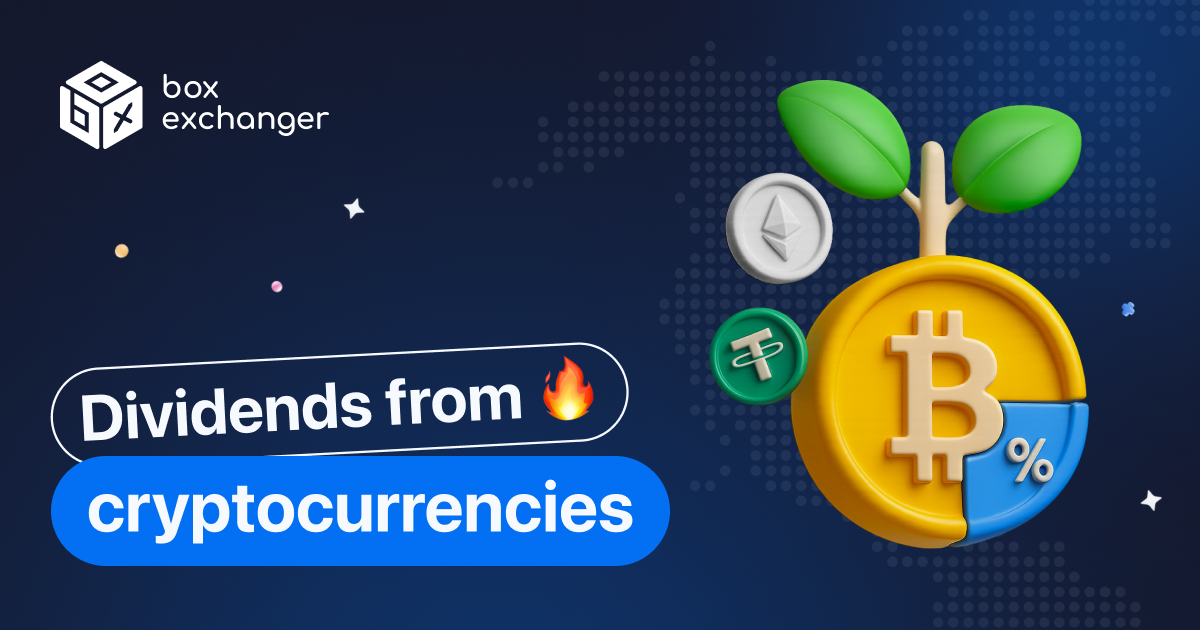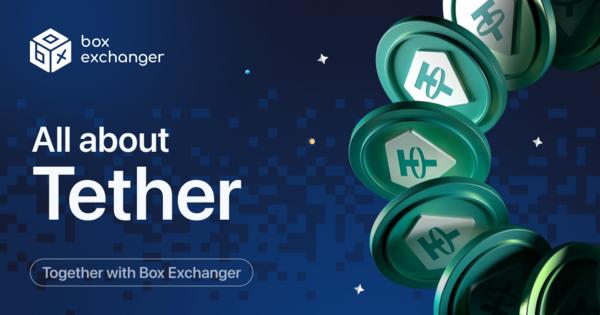5 min.
How Cryptocurrencies Pay Dividends
Added: July 23, 2025

Cryptocurrencies are opening up new opportunities for passive income, and many people who are beginning to explore this niche are wondering how cryptocurrencies pay dividends. Unlike traditional stocks, where dividends are paid out of the company's profits, the process works differently in cryptocurrencies, often through mechanisms like staking or revenue sharing platforms. On various platforms like Binance, WhiteBit, and CoinMarketCap, users can exchange cryptocurrencies and explore ways to earn money, including cryptocurrency dividends. Today, we will look into what cryptocurrency dividends are, how they can be received, and what risks to consider.
What does cryptocurrency dividends mean
Dividends are a portion of a company's profits distributed to the shareholders who invested in it. In the crypto sphere, cryptocurrency dividends have a different meaning. They are rewards that investors receive for owning certain tokens or participating in supporting blockchain networks. For example, token holders can earn income through steaking on Proof-of-Stake (PoS) networks or from platforms sharing a portion of their revenue.
Staking involves blocking tokens on the network to secure it and process transactions, for which additional tokens are awarded. Another example is token exchanges, such as KuCoin Shares (KCS), which distribute a portion of trading fees to holders. This makes cryptocurrencies an attractive tool for those seeking passive income.
Cryptocurrency as a passive income tool
Cryptocurrencies offer several ways on how to make money from cryptocurrency passively, making them a popular choice for investors. The main methods include:
- Staking: PoS blockchain token holders blockchain their assets to support the network and receive rewards.
- Holding revenue-sharing tokens: some projects, especially exchange-traded tokens, share profits with holders.
- Yield Farming: participation in DeFi protocols where users provide liquidity and receive tokens as rewards.
- Mining: although this is a more active process, some miners set up systems to generate a steady income.
These methods allow you to earn without having to actively trade, which is especially convenient for long-term investors.
How crypto dividends differ from classic dividends
- Cryptocurrency dividends differ significantly from traditional dividends:
- The source of income: traditional dividends are paid out of company profits, whereas cryptocurrency dividends are often linked to network mechanisms such as staking or commission distributions.
- Form of payment: in conventional finance, dividends come in fiat currency, whereas in cryptocurrencies they come in the form of tokens, which adds volatility.
- Frequency of payment: classic dividends are usually paid quarterly, while cryptocurrency dividends can be paid daily or weekly.
- Risks: cryptocurrency assets are subject to high volatility, which affects the value of dividends received.
The main ways to get dividends from cryptocurrencies
There are several ways to get dividends from cryptocurrencies, each with its own peculiarities:
Staking in PoS networks
Staking is a process in which cryptocurrency owners blockchain their tokens to support the operation of a blockchain with a Proof-of-Stake (PoS) mechanism, earning passive income for doing so. It's essentially like a savings account at a bank, where your coins are used to keep the network secure and you are rewarded in the form of new tokens. Validators, who do the bulk of the work processing transactions, pick up some of the revenue, but even ordinary users can earn by participating through staking pools.
According to CoinMarketCap Academy, rewards depend on the cryptocurrency, provider and length of blockchain, with annualised yields (APY) ranging up to 19.5 per cent for some stablecoins, such as UST on the Anchor platform. However, the risk of slashing (penalty for incorrect actions) exists, which requires careful project selection.
Holding revenue-sharing tokens
Holding revenue-sharing tokens allows you to earn passive income, especially through tokenisation platforms such as KuCoin Shares (KCS). According to data from KuCoin, KCS holders receive 50% of the exchange's daily trading fees, making them an attractive choice for investors holding a minimum of 6 KCS. This method provides stable payouts based on trading volume on the platform and does not require active participation.
Dividend Innovation Using Artificial Intelligence
In 2025, SingularityNET, as a founding member of the Artificial Superintelligence (ASI) Alliance, uses advanced technologies such as Knowledge Layer and OpenCog Hyperon to optimise FET (ASI) token steaking, which is directly linked to dividend generation.
Users who participate in the staking to secure the decentralised AI ecosystem are rewarded in the form of tokens, which can be seen as a dividend depending on the activity of the network. The Deep Funding programme supports the development of new AI projects, strengthening the ecosystem and potentially increasing the profitability of steaking, making this approach an innovative source of passive income.
Advantages of receiving dividends in cryptocurrency
There are a number of advantages to receiving them:
- High yield: crypto dividends often surpass the yields of familiar investments such as bank deposits.
- Affordability: participating in steaking or DeFi is accessible to users with small amounts.
- Diversification: cryptocurrencies add diversity to an investment portfolio.
- Network support: participation in a pool contributes to the security and decentralisation of blockchain networks.
Risks and Disadvantages
Although attractive, there are risks associated with receiving dividends from cryptocurrencies:
- Variability: cryptocurrency prices can change dramatically, affecting asset values and dividends.
- Regulatory risks: regulatory uncertainty can affect taxation and the legality of income.
- Technical risks: vulnerabilities in smart contracts or attacks on the network could result in loss of funds.
- Fraud: there is a risk of investing in unreliable projects or pyramid schemes.
Investors should scrutinise projects carefully and use reliable platforms for safe asset exchange.
How to choose the best cryptocurrency for dividends
Choosing the best tokens for dividends requires analysing several factors:
1. Project reputation: research the project's team, history and partners.
2. Technology and usecase: make sure the blockchain has a clear application, such as smart contracts or decentralised applications.
3. Community and acceptance: an active community and broad acceptance increase the stability of the project.
4. Historical performance: analyse cryptocurrency returns and payment stability.
5. Security: evaluate the protocol's protection against vulnerabilities.
6. Yield: compare reward rates and terms of participation.
Using platforms such as CoinMarketCap or CoinGecko will help gather up-to-date information about projects.
Conclusion
Receiving dividends from cryptocurrencies is a promising way to earn passive income that can yield high returns. However, it is important for investors to consider risks such as volatility and regulatory uncertainties. Thorough research and using reliable sources will help maximise returns and minimise risks.
The information provided in this article is for informational purposes only and does not constitute a guide to action, financial recommendation or investment advice. Cryptocurrency investments involve a high level of risk and each investor should conduct his/her own analyses, assess his/her financial capabilities and consult with professional financial advisors before making investment decisions.
Frequently Asked Questions
What is the minimum deposit needed to start steaking?
The minimum deposit for staking varies: on KuCoin, 6 KCS is sufficient, while on Binance you can start with small amounts, such as 0.001 ETH, depending on the chosen programme.
Which cryptocurrencies give the highest yields for steaking?
Cryptocurrencies with high yields include UST on Anchor (up to 19.5% per annum) and Solana (around 5%), but exact figures depend on market conditions and platform.
Also read

December 3, 2025
On-chain and off-chain transactions
On-chain and off-chain transactions for cryptocurrency exchange owners are not just theory—they are the foundation ...

November 26, 2025
Consensus mechanism in blockchain
The consensus mechanism in blockchain is a set of rules according to which nodes add new entries to the distributed...

November 21, 2025
All about Tether
When an online exchange owner wants to understand everything about Tether, it's not just about the exchange rate, b...